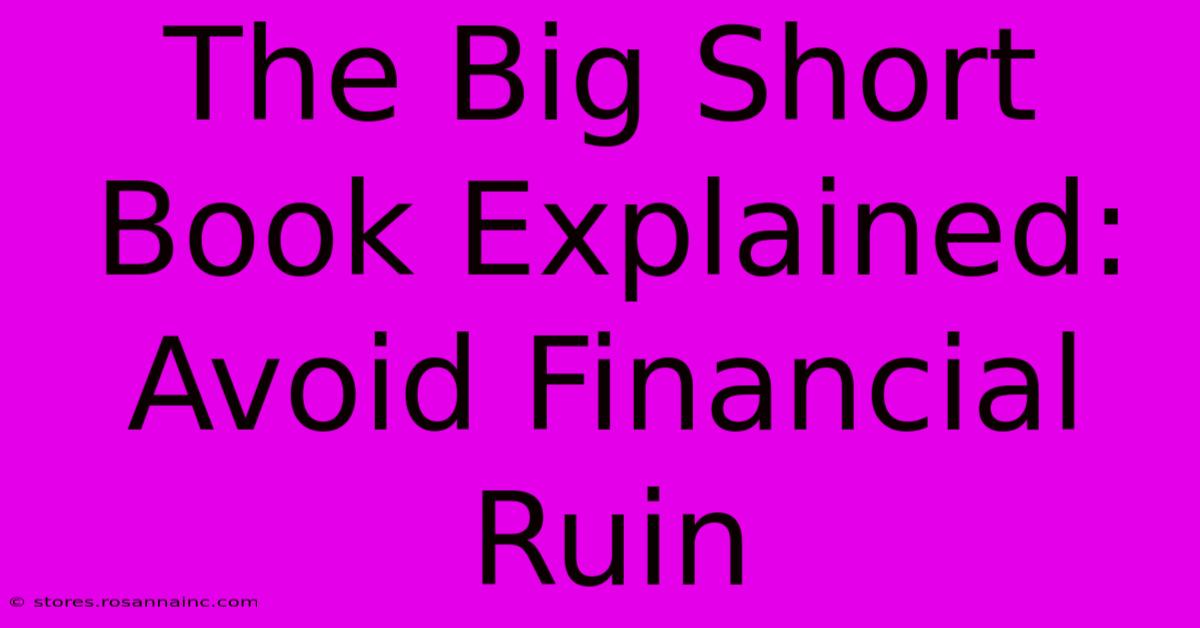The Big Short Book Explained: Avoid Financial Ruin

Table of Contents
The Big Short Book Explained: Avoid Financial Ruin
Michael Lewis's The Big Short: Inside the Doomsday Machine isn't just a gripping tale of financial brinkmanship; it's a crucial lesson in understanding risk and potentially avoiding financial ruin. The book details how a handful of shrewd investors saw the impending collapse of the US housing market and profited handsomely from it—while the rest of the world suffered. This explanation will break down the key elements of the book and offer insights into how to protect yourself from similar financial catastrophes.
Understanding the Subprime Mortgage Crisis
The heart of The Big Short lies in the subprime mortgage crisis. This crisis wasn't a sudden event; it was the culmination of years of reckless lending practices. Banks were offering mortgages to individuals with poor credit histories (subprime borrowers), often with adjustable-rate mortgages (ARMs) that started with low interest rates but drastically increased over time. These mortgages were then bundled together into complex financial instruments called mortgage-backed securities (MBS) and collateralized debt obligations (CDOs), sold to investors worldwide.
Key Players and Their Strategies
Lewis profiles several key individuals who foresaw the impending doom:
-
Michael Burry: A physician-turned-hedge-fund-manager who was among the first to recognize the inherent risk in MBS. He made a massive bet against the housing market by using credit default swaps (CDS), essentially insurance policies against mortgage defaults.
-
Steve Eisman: A cynical hedge-fund manager who, despite his initial skepticism, saw the potential for enormous profits and eventually joined the bet against the housing market.
-
Greg Lippmann: A Deutsche Bank trader who played a crucial role in facilitating the bets against the housing market, enabling investors like Burry and Eisman to profit.
-
Ben Hockett and Jamie Mai: Two relatively unknown investors who also identified the flaws in the system and successfully profited from the crisis.
The Dangers of Complex Financial Instruments
One of the most important lessons from The Big Short is the inherent danger of complex financial instruments like MBS and CDOs. These products were so intricately designed that even experts struggled to fully understand the risks involved. This lack of transparency and understanding fueled the crisis. The complexity masked the underlying risk, allowing the market to grow dangerously oversized and unsustainable.
Learning from the Mistakes
The subprime mortgage crisis was not an isolated incident. Similar bubbles have occurred throughout history. Understanding the underlying principles – excessive risk-taking, poor regulation, and a lack of transparency – is crucial to avoiding future financial disasters. Therefore, understanding these points is essential for avoiding financial ruin:
- Diversify your investments: Don't put all your eggs in one basket. Spread your investments across different asset classes to reduce risk.
- Understand what you're investing in: Before investing in any financial product, take the time to understand its risks and potential returns. Don't invest in anything you don't fully comprehend.
- Be wary of high returns: If something sounds too good to be true, it probably is. High returns often come with high risks.
- Stay informed: Keep up-to-date on current economic conditions and financial news. Understanding the market landscape is essential for making informed decisions.
- Consult a financial advisor: A qualified financial advisor can help you create a personalized investment strategy that aligns with your goals and risk tolerance.
Protecting Yourself from Financial Ruin
The lessons of The Big Short extend far beyond the intricacies of mortgage-backed securities. They underscore the importance of financial literacy, responsible lending practices, and cautious investing. By understanding the risks involved in the financial markets and taking steps to mitigate those risks, you can significantly improve your chances of avoiding financial ruin. Financial literacy is not just about understanding investments; it’s about understanding risk, debt, and responsible financial management.
This includes understanding your own financial situation, managing debt responsibly, and creating a realistic budget. The book serves as a stark reminder that seemingly stable systems can collapse, and being prepared is the best defense against financial hardship. Reading The Big Short is not simply about understanding a past crisis; it’s about safeguarding your future.

Thank you for visiting our website wich cover about The Big Short Book Explained: Avoid Financial Ruin. We hope the information provided has been useful to you. Feel free to contact us if you have any questions or need further assistance. See you next time and dont miss to bookmark.
Featured Posts
-
21 Rescued From Nsw Victoria Storms
Feb 10, 2025
-
Angers Marseille 0 2 Defaite Du Sco
Feb 10, 2025
-
Eagles Barkley Impact On And Off Field
Feb 10, 2025
-
Conquer Raging Blast 2 Secret Techniques Revealed
Feb 10, 2025
-
Confused About Mythica Watch Order Solved
Feb 10, 2025
